Backgrounder
Digital Art or Visual Propaganda? China’s New Wave of Online Political Satire
Political, patriotic art mocking Western leaders is welcomed by social media users and propagated by Chinese officials.
Published
3 years agoon
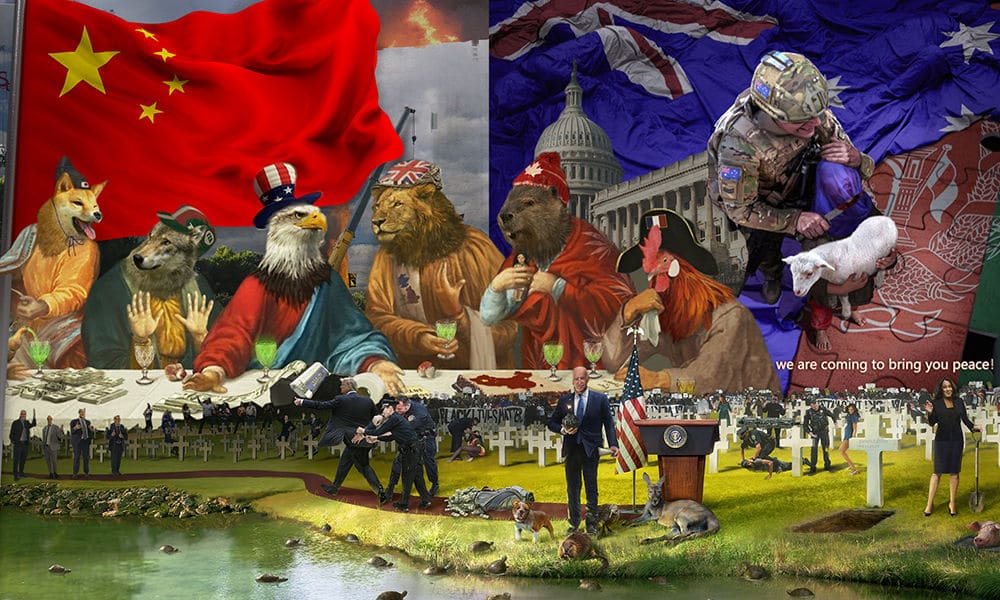
PREMIUM CONTENT ARTICLE
A specific genre of political satire has been gaining popularity on Chinese social media lately, with some images even making international headlines. While political satire mocking Chinese authorities is generally soon taken offline, these online works are brought to the limelight by Chinese official channels. Is it grassroots digital art? Or is it official visual propaganda?
When the parody image ‘The Last G7’ went viral on Chinese social media in June of 2021, it made international headlines for insulting the G7 summit, the West and Christianity, ridiculing ‘double-faced’ Australia, bashing Japan over Fukushima water, and offending India’s COVID19 situation. There was enough satirical symbolism and detail in the image to offend virtually any country that was -implicitly- portrayed in it.
Some media headers suggested the image was created by Chinese state media, others said it was done by ‘Chinese trolls’ or Chinese authorities.
The image was actually created by a Chinese computer graphics illustrator from Beijing who is active on social media, where he also sells his digital art online.
Online political satire in China has been around since the early start of social media in China and is often seen as a form of online activism. In media articles and academic literature focused on online political satire in China, the phenomenon is often discussed within the framework of censorship and dissidence, as a practice of resistance against Chinese authorities. Political satire can exist in many forms, from funny word jokes to catchy songs, from viral gifs to sophisticated cartoons.
Renowned Chinese political cartoon artists such as Badiucao (巴丢草), Hexie Farm (蟹农场), Kuang Biao (邝飚), and Rebel Pepper (变态辣椒) were previously active on Chinese social media platform Weibo, and their accounts were shut down dozens of times before publishing their work within China’s online environment became virtually impossible.
These artists are known for drawing cartoons that criticize and mock Chinese leaders, the central government, or their policies. Their work fits the narrative of online political satire being used as a weapon to resist authoritarian rule in spite of the highly censored online climate they exist in (Shao & Liu 2019, 517).
What exactly is political satire? It is “a specific form of criticism that ridicules political figures, events, or phenomenon” (ibid). Visual political satire is especially relevant within the context of Chinese social media because images allow for a creative form of expression, an outlet to critique political events, that is harder to detect by online censors than the use of potentially sensitive words and terms.
But what if political satire does not critique the Chinese party-state at all? What if it actually does not conflict with party ideology, or even suits the narratives that are propagated by Chinese officials?
Recent Examples of Chinese Political Satire on Social Media
In late December of 2020, a photoshopped image of an Australian soldier murdering a child stirred controversy on social media and beyond. The soldier, who is holding a knife to the throat of a child, is standing on an Australian flag, the shadows of bodies can be discerned lying on the floor. The image – which alluded to the report regarding unlawful killings of Afghan civilians and prisoners by Australian troops – was shared on Twitter by Chinese Foreign Ministry spokesperson Zhao Lijian. The controversial post led to Australian Prime Minister Scott Morrison demanding an apology from China.
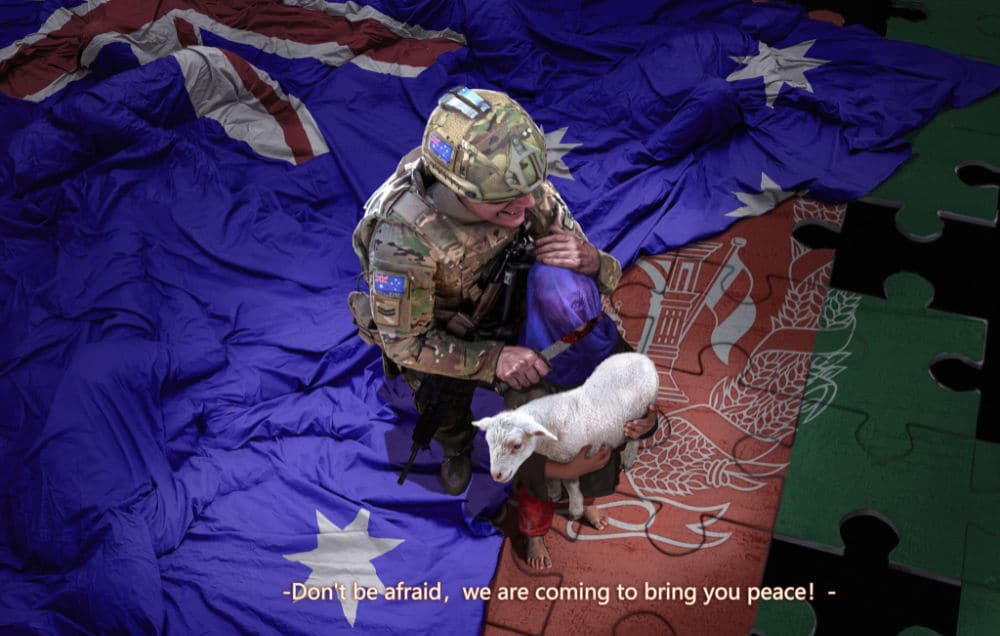
The computer graphic by Wuheqilin that was shared on Twitter by a Chinese official.
In January of 2021, around the time of Biden’s inauguration, another satirical work was shared on Twitter by a senior producer of CGTN (@Peijin_Zhang) and others. Like the earlier image, this political satire was also full of details and symbolism. It shows American President Biden holding a bomb in front of a White House background, while Trump is taken away by officers and Kamala Harris is standing by an open grave reserved for Biden – shovel in hand. The text underneath the image says: “What a paradise of freedom, democracy, and sweet air.”

Artwork titled ‘失乐园·末日余晖’ ‘Paradise Lost-Afterglow’ created by ‘半桶老阿汤’ aka ‘Half Bottle Of Old Soup.’
At the time of the online controversy over the Xinjiang cotton ban by the BCI in March of 2021, another digital illustration titled “Blood Cotton Initiative” made headlines for featuring (BBC) journalists in KKK-style hoods interviewing a scarecrow in a field, cotton-picking slaves in the background.
The image is a response to the allegations of forced labor and human rights abuses in Xinjiang, which various Chinese officials and state media have condemned as being ‘false,’ ‘manipulative,’ and ‘hypocritical’ in light of many western countries’ own human rights records. The image was shared on Twitter by, among others, the official account of China Daily Asia (@Chinadaily_CH) and China Daily Hong Kong (@CDHKedition).
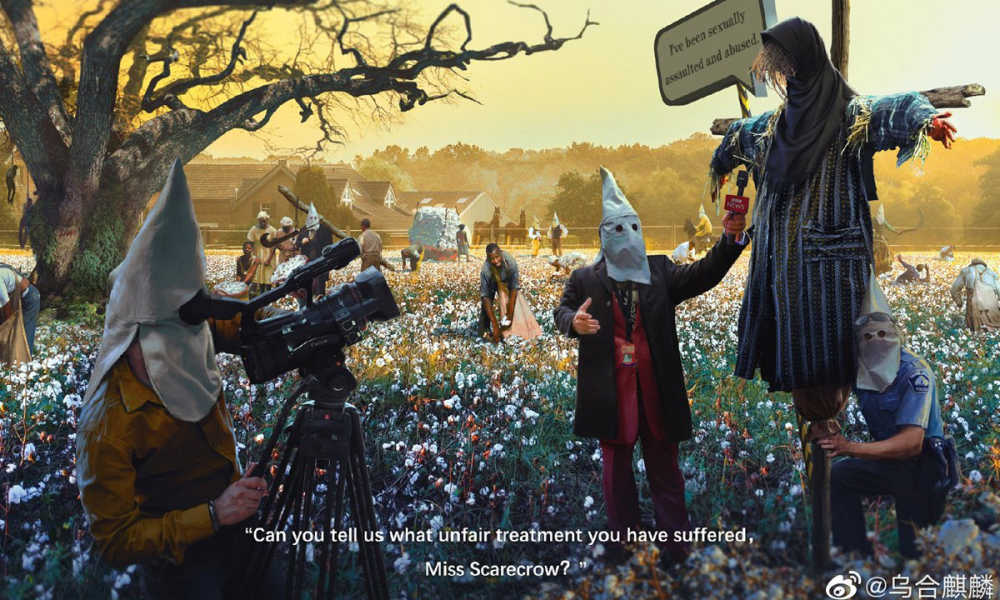
“Blood Cotton Initiative” (血棉花) by Chinese artist Wuheqilin.
In June of 2021, another political satire made headlines, as mentioned earlier in this article. It was the image mocking the G7 members who issued a summit communique that called on China to “respect human rights and fundamental freedoms,” especially in relation to Xinjiang and Hong Kong autonomy, and also pushed for a new inquiry into the origin of the Covid-19 virus (link to pdf). The image, which is a parody of The Last Supper mural painting, is titled ‘The Last G7’ (最后的G7).
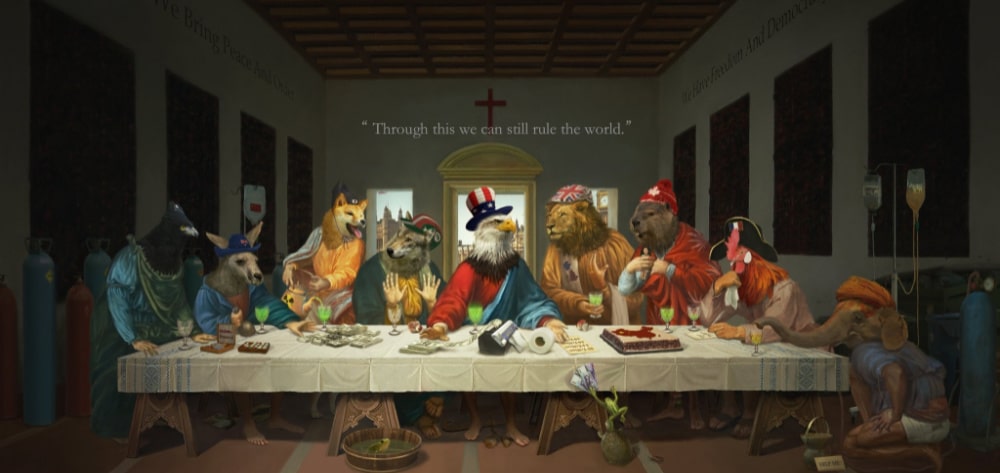
Image ‘The Last G7’ created by ‘半桶老阿汤’ aka ‘Half Bottle Of Old Soup.’
The image shows various animals sitting around the table, supposedly to represent Germany (left), Australia, Japan, Italy, US, UK, Canada, France, and India. Behind them are oxygen tanks, while the elephant on the right (India) is still receiving IV treatment and is not participating in the table talks. The Akita dog (Japan) is serving a green drink from a radioactive tea cattle while the bald eagle in the middle (US) is turning toilet paper into money. The beaver (Canada) is tightly holding on to a Chinese doll – a reference to Huawei executive Meng Wanzhou who has been in Canada ever since she was arrested during a stopover by Canadian police in 2018. On the table, there is a cake with the Chinese flag on it.
“Through this we can still rule the world,” the words above the image state, while the text on the wall in the image says: “We have freedom and democracy.” State newspaper Global Times shared and explained the political satire in an article on June 13.
The Creators Behind the Artwork
Recent Chinese political satire images circulating on social media have been labeled as ‘propaganda’ by many commenters on Twitter, who assume the images were originally published by Chinese state media outlets. But although these images were often shared by official (media) accounts, their creators are seemingly unaffiliated with state media.
Chinese social media has seen a surge of (CG) artists dedicated to creating patriotic art and political satire mocking Western powers. At this time, the two most noteworthy names are Wuheqilin and Bantong Laoatang.
‘WUHEQILIN’ 乌合麒麟
The aforementioned Australian piece and the ‘Blood Cotton Initiative’ image both were created by Wuheqilin (乌合麒麟), a professional computer graphic (CG) artist with over 2.8 million followers on his Weibo account, which he opened in 2009. Wuheqilin’s real name is Fu Yu (付昱, 1988) – a business owner and art director from Harbin.
Although Wuheqilin became especially famous for his controversial Australia image of November 2020, his work was featured by Chinese state media before that time. In June of 2020, Global Times (English version) called him a “Wolf Warrior artist” who “strives to use new art to spread truth and inspire patriotism.”
Wuheqilin published his first political artwork on his social media account in 2019, at the time of the Hong Kong protests. In this work, titled ‘A Pretender God,’ the artist takes a critical stance towards the demonstrators, showing them bowing to a monster-like figure resembling the Statue of Liberty.
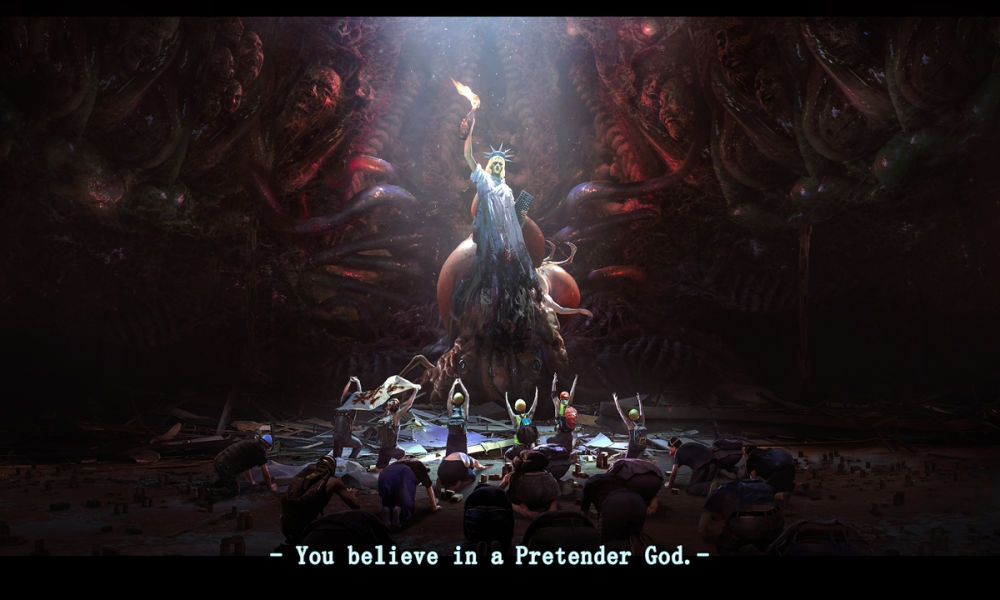
‘A Pretender God’ by Wuheqilin.
Another one of Wuheqilin’s recent viral pieces is titled ‘G7’, an old-looking photograph that was a satirical comparison of the G7 foreign ministers to the leaders of the Eight-Nation Alliance that invaded northern China in response to the Boxer rebellion in 1900. This image was also shared and explained by Global Times.

‘G7’ by Wuqihelin.
Wuheqilin clearly focuses on showing the dark side, hypocrisy, and supposedly bad intentions of Western powers in international politics. Noteworthy enough, he often uses English phrases in his work to emphasize his point, which may suggest he also intends for his art to be noticed by media and politicians outside of China.
Although Wuheqilin is most famous for political satire mocking Western powers, he also makes non-satirical patriotic art, such as the piece he dedicated to Chinese agronomist Yuan Longping (袁隆平), China’s ‘Father of Hybrid Rice,’ who passed away in May of 2021.

“I Always Had Two Dreams” “我一直有两个梦想” by Wuheqilin.
Over the past year, Wuheqilin and his work are often praised by Chinese official media outlets. It is often shared by English-language state media, or retweeted by Chinese officials or media accounts that are active on Twitter. Together with the fact that Wuheqilin uses English in his artwork, his work has gained major attention both in- and outside of China.
‘HALF BOTTLE OF OLD SOUP’ 半桶老阿汤
The creator of ‘The Last G7’ image and the White House image is active on social media under various names. On Weibo, where he has over 39,000 followers, the artist is known as @半桶老阿汤 (Bàntǒng lǎo ā tāng). On Twitter, he has an account under the name ‘Half Bottle Of Old Soup’ (@Half_soup), a direct translation of his nickname. The artist also has a site under the name Henry Yu. His webshop is under the ‘Laoatang’ nickname, which we will use here.
Laoatang is a concept designer and computer graphic artist from Beijing. On his Weibo account, the artist has been sharing artwork by himself and others for years. Like Wuheqilin, he has an online cloud link where people can download artworks for free, but he also has a site where people can support him by buying digital art files for the small price of 10-15 yuan ($1.5-$2.5).
Like Wuheqilin, Laoatang’s artwork is also often focused on mocking the supposed hypocrisy of Western powers regarding international affairs involving China. ‘The Last G7’ was the first work by Half Soup to make (international) headlines, but he previously did many other works in response to political affairs.
His work ‘That’s What U.S. did'(‘这是你们的愚蠢行径,我们不会’) was published at the time when news over the BCI [Better Cotton Initiative] Xinjiang cotton ban over forced labor concerns made waves in China.

‘That’s What U.S. Did’ by 半桶老阿汤
The image is part of a computer graphic video that shows black slaves working in American cotton fields while singing ‘My Lord Sunshine Sunrise.’ The next scene shows how one black man is held at gunpoint by a white hooded figure, a scarecrow with a BCI logo showing in the foreground. The words “That’s what U.S. Did, Not Us!” come up while two black figures can be seen hanging from the gallows.
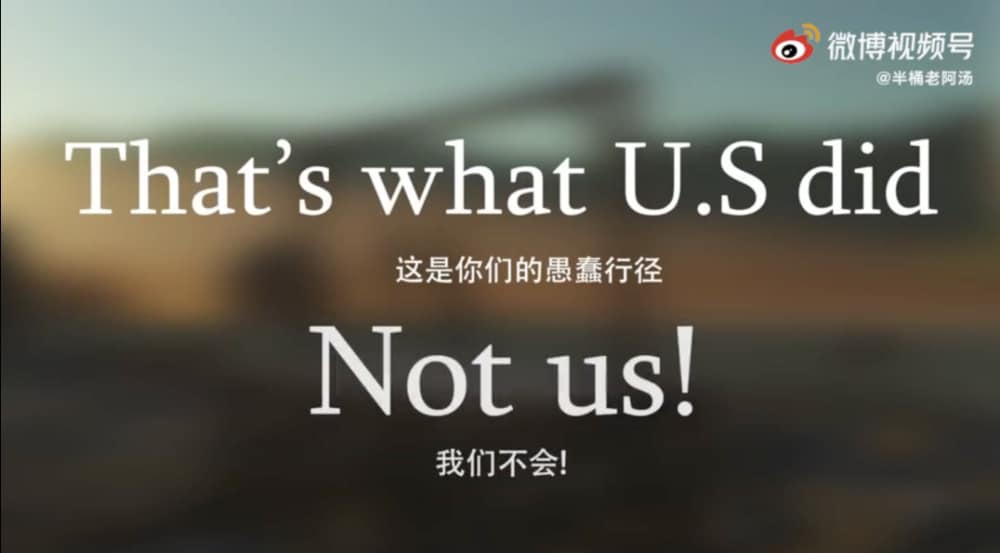
In a different style, Laoatang has also created various other political satire illustrations. One from June 2021 is called ‘Investigate Thoroughly! Except Here’ (‘彻查!除了这儿’). It shows members of the WHO research team standing in front of the American army biochemical lab at Fort Detrick which is closed and guarded by Biden. In the background, there’s the scenery of a happy and open Wuhan city.

‘Investigate Thoroughly! Except Here’ (‘彻查!除了这儿’) by 半桶老阿汤 / Half Bottle of Old Soup
The illustration is a response to U.S. calls for a thorough investigation into the origins of the novel coronavirus in China, while a possible link between the Fort Detrick institute and the COVID19 pandemic are allegedly ignored. This image was also shared by the Communist Youth League on social media.
OTHERS & INTERTEXTUALITY
Online creators such as Wuheqilin and Laoatang move in certain Chinese social media circles of artists producing work in similar genres who share each other’s work and comment on it. At times, there is also some kind of intertextuality or connection between these artworks.
A good example of this intertextuality is the work by the artist who is active on Weibo under the name ‘钢铁时代2011’ (Gangtie Shidai 2011). In December of 2020, they published the artwork below that reflects on the international commotion involving the Australian soldier image by Wuheqilin, which was tweeted out by Chinese official Zhao Lijian.

“Damn it, they know what we’ve done” by @钢铁时代2011 [Gangtie Shidai 2011].
The image shows artist Wuheqilin holding up one of his artworks relating to the alleged Australian war crimes in Afghanistan, while Zhao Lijian is holding up the other image by Wuheqilin. In the front, Australian Prime Minister Scott Morrison is depicted turning his back to the images, with the sentence: “Damn it, they know what we’ve done.”
During the controversy over the BCI ban on Xinjiang cotton, there was also an outpour of online (unofficial) political art. Beijing illustrator Yang Quan @插画杨权 (1990) is also among those creating online political/patriotic art. He published an image titled “Cotton is Soft, but China is Strong.”

‘Cotton is Soft, But China is Strong’, by @插画杨权.
The dog has the letters “H” and “M” coming from his bloody mouth, referring to fashion chain H&M which was one of the major Western brands publishing a statement regarding the ban on Xinjiang cotton (read more here). Again, as in most of the recent works produced by the artists in this genre, the message of the image is reinforced through a text in English, suggesting the work is also meant for an international audience to understand.
In Between Censorship and Propaganda
Propaganda is part of Chinese media, and a ‘new’ kind of propaganda has been part of Chinese social media propaganda efforts over the past few years (also see here, here, here, here).
But separated from those mainstream, more centralized propaganda efforts, the artists mentioned in this article are part of a ‘new wave’ of political satire on Chinese social media because:
– They are independent artists and/or not officially part of state media outlets or the CCP Propaganda Bureau.
– Their style is very different from official (online) propaganda posters and imagery.
– Their works are labeled as ‘art’ and have definite artworks qualities; they are unique, are made with skill and technique, and are filled with symbolism and detail.
– Their works are praised and welcomed by state media outlets and/or government officials, as these are shared and propagated through multiple official channels.
– These artists and their creations are widely celebrated and praised by Chinese social media users.
The phenomenon of artists who are unrelated to official agencies creating political art that is then used as a tool for propaganda is not unique in the history of Chinese propaganda or that of other countries, but it is very noteworthy in the context of the short history of social media in China, where political satire is often targeted at Chinese government officials and policies and therefore censored.
Perhaps you could say it is not surprising at all that the political satire we see most in Chinese social media today is directed at foreign leaders and Western powers, since any images mocking the Chinese government would be censored immediately.
But to solely interpret these political images through this one-dimensional view would not do justice to the artwork, the artists, nor to the art aficionados, since there are several influences at play within the creation of this genre.
> Digital Art & Nationalism
There are many young artists in China today who are patriotic and nationalistic, and who use art as a way to express their political views. They do so in various ways, through personal websites, social media, cloud downloads, etc, providing an alternative to official, controlled media sources. Propaganda sometimes becomes art, and art sometimes becomes propaganda. These dynamics do not automatically turn these artists into ‘Chinese trolls,’ as some foreign media labeled them.
Artists such as Wuheqilin or the aforementioned artist named Yang Quan all belong to the post-80 generation. In this current, post-Mao generation, you find a “fourth generation” of nationalism, as described by Peter Hays Gries in China’s New Nationalism. This nationalism is very much alive in China’s online environment, and it is fused with anti-western sentiment that partly builds on the “one hundred years of humiliation” of China at the hands of the West (Zhang 2012, 2). Although this generation, that grew up amid China’s rapid economic growth, did not directly experience the past humiliations upon which their nationalist narratives are constructed, this history remains central to understandings of Chinese national identity and its place in the world today (Wang 2-11).
As pointed out by Tao Zheng (2012), the articulation and promotion of nationalist views by individuals and groups independent of the state have been a significant part of Chinese online culture for many years, with several online movements and campaigns focusing on pointing out “western arrogance and prejudice.” The current wave of political digital art is just another form of expression of this type of “cyber nationalism.”
> Building Communities
Another reason why it would be too crude to simply label China’s recent online political satire as ‘propaganda’ is because it has emerged from a dynamic digital environment where netizens engage in a participatory activity of creating, sharing, commenting, recreating, connecting, etc. – and it is through these practices that the artworks become meaningful.
In ‘The Networked Practice of Online Political Satire in China’ by Guobin Yang and Min Jiang (2015), the authors argue that the sharing and circulation of online political satire in China is a “networked social practice” that is actually more important than the meaning and significance of the content itself. It is a grassroots political expression that, in their mode of unofficial network operation, could be seen as “popular mobilizations against power” (216). Yang and Jiang also emphasize the social function of political satire, where the reception is just as relevant as the production.
> A Fine Line
In the end, the question of whether these works are grassroots digital artworks or official propaganda pieces is perhaps not one of either/or: they are both. They saw the light as digital artworks and then became tools within a framework of official propaganda once they were praised, shared, and used by Chinese state media and officials to project their own strategies.
The creators of these artworks, however, walk a fine line. When their artworks no longer suit the strategic interests propagated by official channels, they are still at risk of being censored within the highly controlled digital environment they operate in. In that case, their online influence, magnified by official actors, could actually be held against them.
For now, artists such as Wuheqilin are thriving on Chinese social media. In his last post, Wuheqilin drew his own conclusion about the current state of China’s online environment, writing:
“For the public intellectuals and those with vested interests who once held on to the power of speech, these are perhaps the darkest times, because their “decade-long campaign for Enlightenment has been lost.” But for ordinary Chinese netizens, for those who love this country and believe in it, we have unprecedented confidence, creativity, and cohesion. These are the best of times, and we are marching towards the brightest future.”
By Manya Koetse (@manyapan)
Follow @whatsonweibo
With special thanks to Piervittorio Milizia.
References
Gries, Peter Hays. 2004. China’s New Nationalism: Pride, Politics, and Diplomacy. Berkely and London: University of California Press.
Shao Li, Liu Dongshu. 2019. “The Road to Cynicism: The Political Consequences of Online Satire Exposure in China.” Political Studies 67(2): 517-536.
Yang, Guobin and Min Jiang. 2015. “The Networked Practice of Online Political Satire in China: Between Ritual and Resistance.” The International Communication Gazette 77(3): 215-231.
Zhang, Tao. 2012. “Anti-CNN and ‘April Youth’: Anti-Western Sentiment in Youth-oriented Chinese Online Media.” In Hernandez, L. (ed.), China and the West: Encounters with the other in Culture, Arts, Politics and Everyday Life,
Cambridge Scholars, 1-16.
Zheng Wang. 2012. Never Forget National Humiliation: Historical Memory in Chinese Politics and Foreign Relations. New York: Columbia University Press.
Featured image created by What’s on Weibo, highlighting and using parts of various digital artworks by @乌合麒麟, @半桶老阿汤.
Spotted a mistake or want to add something? Please let us know in comments below or email us. First-time commenters, please be patient – we will have to manually approve your comment before it appears.
©2021 Whatsonweibo. All rights reserved. Do not reproduce our content without permission – you can contact us at info@whatsonweibo.com.
Manya Koetse is the founder and editor-in-chief of whatsonweibo.com. She is a writer, public speaker, and researcher (Sinologist, MPhil) on social trends, digital developments, and new media in an ever-changing China, with a focus on Chinese society, pop culture, and gender issues. She shares her love for hotpot on hotpotambassador.com. Contact at manya@whatsonweibo.com, or follow on Twitter.

Backgrounder
“Oppenheimer” in China: Highlighting the Story of Qian Xuesen
Qian Xuesen is a renowned Chinese scientist whose life shares remarkable parallels with Oppenheimer’s.
Published
10 months agoon
September 16, 2023By
Zilan Qian
They shared the same campus, lived in the same era, and both played pivotal roles in shaping modern history while navigating the intricate interplay between science and politics. With the release of the “Oppenheimer” movie in China, the renowned Chinese scientist Qian Xuesen is being compared to the American J. Robert Oppenheimer.
In late August, the highly anticipated U.S. movie Oppenheimer finally premiered in China, shedding light on the life of the famous American theoretical physicist J. Robert Oppenheimer (1904-1967).
Besides igniting discussions about the life of this prominent scientist, the film has also reignited domestic media and public interest in Chinese scientists connected to Oppenheimer and nuclear physics.
There is one Chinese scientist whose life shares remarkable parallels with Oppenheimer’s. This is aerospace engineer and cyberneticist Qian Xuesen (钱学森, 1911-2009). Like Oppenheimer, he pursued his postgraduate studies overseas, taught at Caltech, and played a pivotal role during World War II for the US.
Qian Xuesen is so widely recognized in China that whenever I introduce myself there, I often clarify my last name by saying, “it’s the same Qian as Qian Xuesen’s,” to ensure that people get my name.
Some Chinese blogs recently compared the academic paths and scholarly contributions of the two scientists, while others highlighted the similarities in their political challenges, including the revocation of their security clearances.
The era of McCarthyism in the United States cast a shadow over Qian’s career, and, similar to Oppenheimer, he was branded as a “communist suspect.” Eventually, these political pressures forced him to return to China.
Although Qian’s return to China made his later life different from Oppenheimer’s, both scientists lived their lives navigating the complex dynamics between science and politics. Here, we provide a brief overview of the life and accomplishments of Qian Xuesen.
Departing: Going to America
Qian Xuesen (钱学森, also written as Hsue-Shen Tsien), often referred to as the “father of China’s missile and space program,” was born in Shanghai in 1911,1 a pivotal year marked by a historic revolution that brought an end to the imperial dynasty and gave rise to the Republic of China.
Much like Oppenheimer, who pursued further studies at Cambridge after completing his undergraduate education, Qian embarked on a journey to the United States following his bachelor’s studies at National Chiao Tung University (now Shanghai Jiao Tong University). He spent a year at Tsinghua University in preparation for his departure.
The year was 1935, during the eighth year of the Chinese Civil War and the fourth year of Japan’s invasion of China, setting the backdrop for his academic pursuits in a turbulent era.
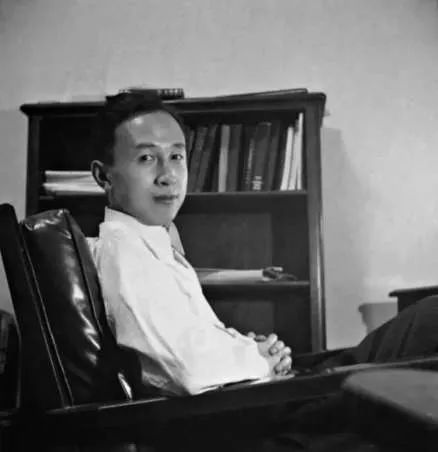
Qian in his office at Caltech (image source).
One year after arriving in the U.S., Qian earned his master’s degree in aeronautical engineering from the Massachusetts Institute of Technology (MIT). Three years later, in 1939, the 27-year-old Qian Xuesen completed his PhD at the California Institute of Technology (Caltech), the very institution where Oppenheimer had been welcomed in 1927. In 1943, Qian solidified his position in academia as an associate professor at Caltech. While at Caltech, Qian helped found NASA’s Jet Propulsion Laboratory.
When World War II began, while Oppenheimer was overseeing the Manhattan Project’s efforts to assist the U.S. in developing the atomic bomb, Qian actively supported the U.S. government. He served on the U.S. government’s Scientific Advisory Board and attained the rank of lieutenant colonel.

The first meeting of the US Department of the Air Force Scientific Advisory Board in 1946. The predecessor, the Scientific Advisory Group, was founded in 1944 to evaluate the aeronautical programs and facilities of the Axis powers of World War II. Qian can be seen standing in the back, the second on the left (image source).
After the war, Qian went to teach at MIT and returned to Caltech as a full-time professor in 1949. During that same year, Mao Zedong proclaimed the establishment of the People’s Republic of China (PRC). Just one year later, the newly-formed nation became involved in the Korean War, and China fought a bloody battle against the United States.
Red Scare: Being Labeled as a Communist
Robert Oppenheimer and Qian Xuesen both had an interest in Communism even prior to World War II, attending communist gatherings and showing sympathy towards the Communist cause.
Qian and Oppenheimer may have briefly met each other through their shared involvement in communist activities. During his time at Caltech, Qian secretly attended meetings with Frank Oppenheimer, the brother of J. Robert Oppenheimer (Monk 2013).
However, it was only after the war that their political leanings became a focal point for the FBI.
Just as the FBI accused Oppenheimer of being an agent of the Soviet Union, they quickly labeled Qian as a subversive communist, largely due to his Chinese heritage. While the government did not succeed in proving that Qian had communist ties with China during that period, they did ultimately succeed in portraying Qian as a communist affiliated with China a decade later.
During the transition from the 1940s to the 1950s, the Cold War was underway, and the anti-communist witch-hunts associated with the McCarthy era started to intensify (BBC 2020).
In 1950, the Korean War erupted, with the People’s Republic of China (PRC) joining North Korea in the conflict against South Korea, which received support from the United States. It was during this tumultuous period that the FBI officially accused Qian of communist sympathies in 1950, leading to the revocation of his security clearance despite objections from Qian’s colleagues. Four years later, in 1954, Robert Oppenheimer went through a similar process.
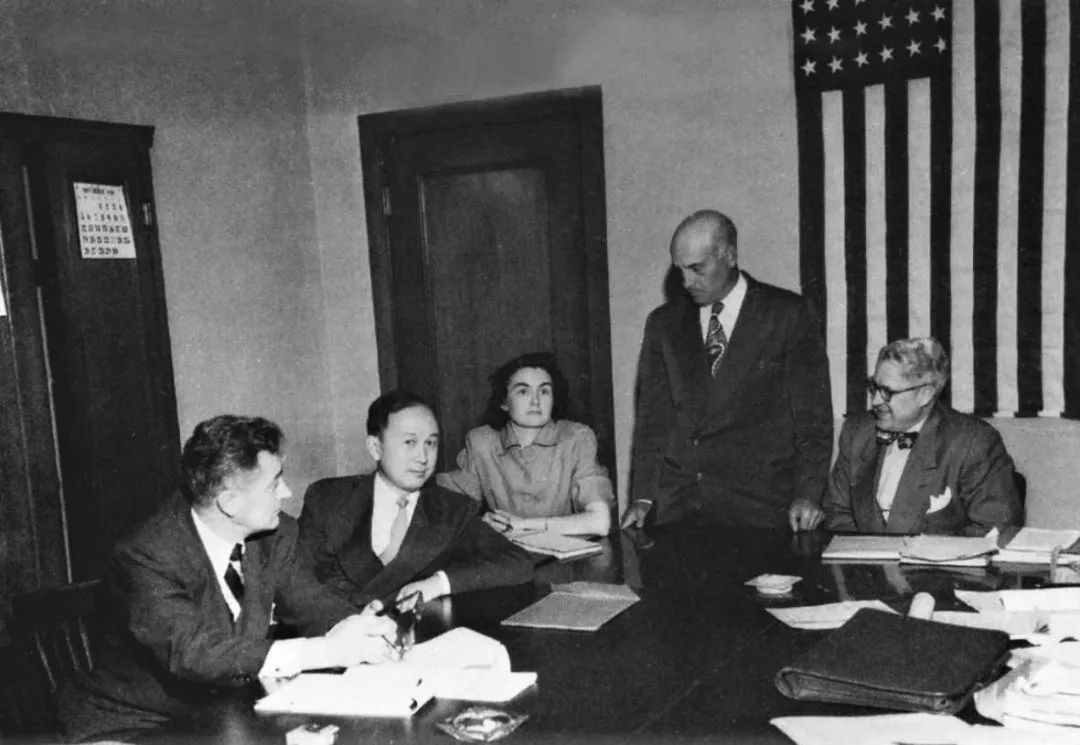
The 1950’s security hearing of Qian (second left). (Image source).
After losing his security clearance, Qian began to pack up, saying he wanted to visit his aging parents back home. Federal agents seized his luggage, which they claimed contained classified materials, and arrested him on suspicion of subversive activity. Although Qian denied any Communist leanings and rejected the accusation, he was detained by the government in California and spent the next five years under house arrest.
Five years later, in 1955, two years after the end of the Korean War, Qian was sent home to China as part of an apparent exchange for 11 American airmen who had been captured during the war. He told waiting reporters he “would never step foot in America again,” and he kept his promise (BBC 2020).
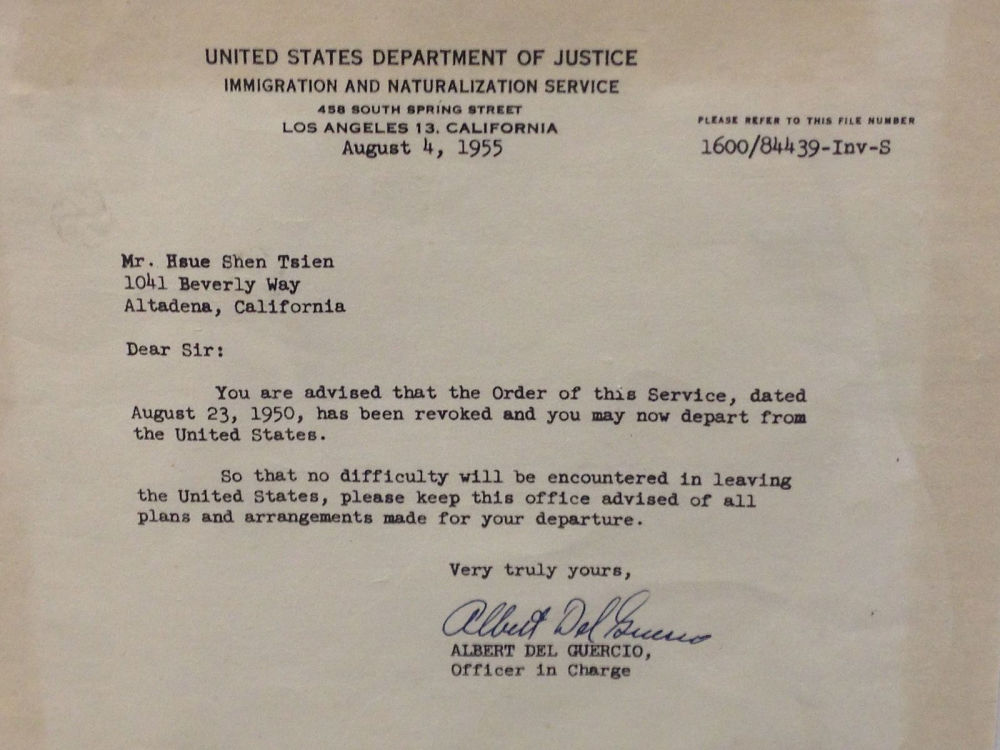
A letter from the US Immigration and Naturalization Service to Qian Xuesen, dated August 4, 1955, in which he was notified he was allowed to leave the US. The original copy is owned by Qian Xuesen Library of Shanghai Jiao Tong University, where the photo was taken. (Caption and image via wiki).
Dan Kimball, who was the Secretary of the US Navy at the time, expressed his regret about Qian’s departure, reportedly stating, “I’d rather shoot him dead than let him leave America. Wherever he goes, he equals five divisions.” He also stated: “It was the stupidest thing this country ever did. He was no more a communist than I was, and we forced him to go” (Perrett & Bradley, 2008).
Kimball may have foreseen the unfolding events accurately. After his return to China, Qian did indeed assume a pivotal role in enhancing China’s military capabilities, possibly surpassing the potency of five divisions. The missile programme that Qian helped develop in China resulted in weapons which were then fired back on America, including during the 1991 Gulf War (BBC 2020).
Returning: Becoming a National Hero
The China that Qian Xuesen had left behind was an entirely different China than the one he returned to. China, although having relatively few experts in the field, was embracing new possibilities and technologies related to rocketry and space exploration.
Within less than a month of his arrival, Qian was welcomed by the then Vice Prime Minister Chen Yi, and just four months later, he had the honor of meeting Chairman Mao himself.
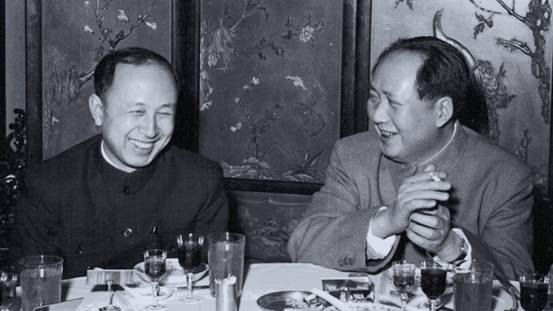
Qian and Mao (image source).
In China, Qian began a remarkably successful career in rocket science, with great support from the state. He not only assumed leadership but also earned the distinguished title of the “father” of the Chinese missile program, instrumental in equipping China with Dongfeng ballistic missiles, Silkworm anti-ship missiles, and Long March space rockets.
Additionally, his efforts laid the foundation for China’s contemporary surveillance system.
By now, Qian has become somewhat of a folk hero. His tale of returning to China despite being thwarted by the U.S. government has become like a legendary narrative in China: driven by unwavering patriotism, he willingly abandoned his overseas success, surmounted formidable challenges, and dedicated himself to his motherland.
Throughout his lifetime, Qian received numerous state medals in recognition of his work, establishing him as a nationally celebrated intellectual. From 1989 to 2001, the state-launched public movement “Learn from Qian Xuesen” was promoted throughout the country, and by 2001, when Qian turned 90, the national praise for him was on a similar level as that for Deng Xiaoping in the decade prior (Wang 2011).
Qian Xuesen remains a celebrated figure. On September 3rd of this year, a new “Qian Xuesen School” was established in Wenzhou, Zhejiang Province, becoming the sixth high school bearing the scientist’s name since the founding of the first one only a year ago.
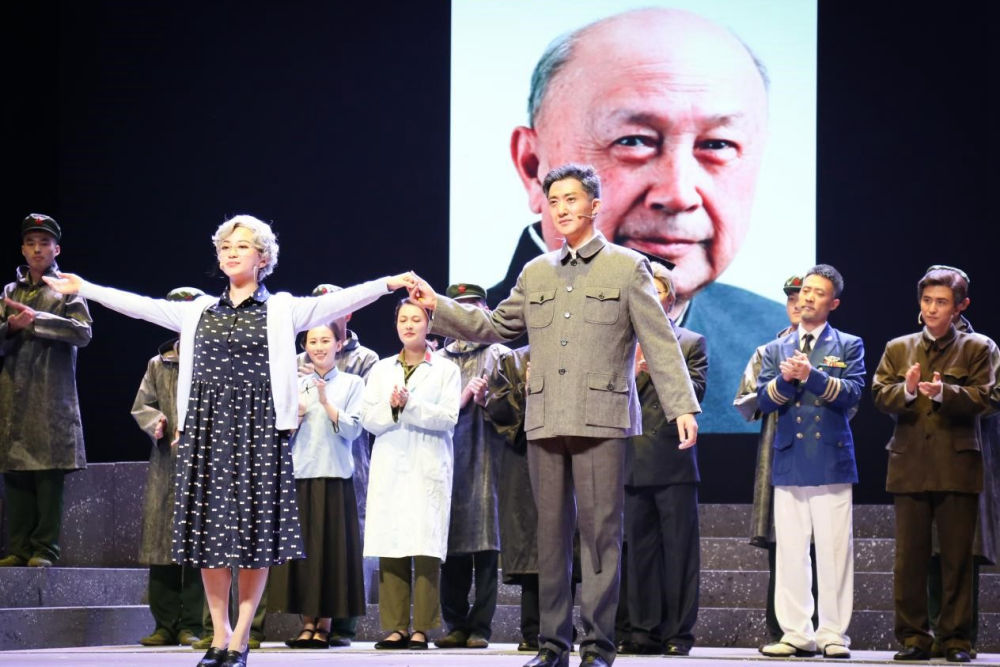
In 2017, the play “Qian Xuesen” was performed at Qian’s alma mater, Shanghai Jiaotong University. (Image source.)
Qian Xuesen’s legacy extends well beyond educational institutions. His name frequently appears in the media, including online articles, books, and other publications. There is the Qian Xuesen Library and a museum in Shanghai, containing over 70,000 artefacts related to him. Qian’s life story has also been the inspiration for a theater production and a 2012 movie titled Hsue-Shen Tsien (钱学森).2
Unanswered Questions
As is often the case when people are turned into heroes, some part of the stories are left behind while others are highlighted. This holds true for both Robert Oppenheimer and Qian Xuesen.
The Communist Party of China hailed Qian as a folk hero, aligning with their vision of a strong, patriotic nation. Many Chinese narratives avoid the debate over whether Qian’s return was linked to problems and accusations in the U.S., rather than genuine loyalty to his homeland.
In contrast, some international media have depicted Qian as a “political opportunist” who returned to China due to disillusionment with the U.S., also highlighting his criticism of “revisionist” colleagues during the Cultural Revolution and his denunciation of the 1989 student demonstrations.
Unlike the image of a resolute loyalist favored by the Chinese public, Qian’s political ideology was, in fact, not consistently aligned, and there were instances where he may have prioritized opportunity over loyalty at different stages of his life.
Qian also did not necessarily aspire to be a “flawless hero.” Upon returning to China, he declined all offers to have his biography written for him and refrained from sharing personal information with the media. Consequently, very little is known about his personal life, leaving many questions about the motivations driving him, and his true political inclinations.
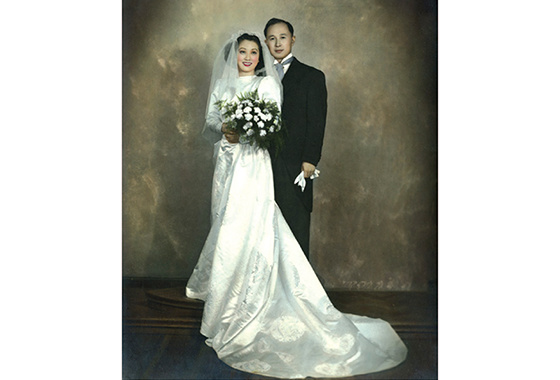
The marriage photo of Qian and Jiang. (Image source).
We do know that Qian’s wife, Jiang Ying (蒋英), had a remarkable background. She was of Chinese-Japanese mixed race and was the daughter of a prominent military strategist associated with Chiang Kai-shek. Jiang Ying was also an accomplished opera singer and later became a professor of music and opera at the Central Conservatory of Music in Beijing.
Just as with Qian, there remain numerous unanswered questions surrounding Oppenheimer, including the extent of his communist sympathies and whether these sympathies indirectly assisted the Soviet Union during the Cold War.
Perhaps both scientists never imagined they would face these questions when they first decided to study physics. After all, they were scientists, not the heroes that some narratives portray them to be.
Also read:
■ Farewell to a Self-Taught Master: Remembering China’s Colorful, Bold, and Iconic Artist Huang Yongyu
■ “His Name Was Mao Anying”: Renewed Remembrance of Mao Zedong’s Son on Chinese Social Media
By Zilan Qian
Follow @whatsonweibo
1 Some sources claim that Qian was born in Hangzhou, while others say he was born in Shanghai with ancestral roots in Hangzhou.
2The Chinese character 钱 is typically romanized as “Qian” in Pinyin. However, “Tsien” is a romanization in Wu Chinese, which corresponds to the dialect spoken in the region where Qian Xuesen and his family have ancestral roots.
This article has been edited for clarity by Manya Koetse
References (other sources hyperlinked in text)
BBC. 2020. “Qian Xuesen: The man the US deported – who then helped China into space.” BBC.com, 27 October https://www.bbc.com/news/stories-54695598 [9.16.23].
Monk, Ray. 2013. Robert Oppenheimer: A Life inside the Center, First American Edition. New York: Doubleday.
Perrett, Bradley, and James R. Asker. 2008. “Person of the Year: Qian Xuesen.” Aviation Week and Space Technology 168 (1): 57-61.
Wang, Ning. 2011. “The Making of an Intellectual Hero: Chinese Narratives of Qian Xuesen.” The China Quarterly, 206, 352-371. doi:10.1017/S0305741011000300
Get the story behind the hashtag. Subscribe to What’s on Weibo here to receive our newsletter and get access to our latest articles:
Spotted a mistake or want to add something? Please let us know in comments below or email us. First-time commenters, please be patient – we will have to manually approve your comment before it appears.
©2023 Whatsonweibo. All rights reserved. Do not reproduce our content without permission – you can contact us at info@whatsonweibo.com.
Backgrounder
Farewell to a Self-Taught Master: Remembering China’s Colorful, Bold, and Iconic Artist Huang Yongyu
Renowned Chinese artist and the creator of the ‘Blue Rabbit’ zodiac stamp Huang Yongyu has passed away at the age of 98. “I’m not afraid to die. If I’m dead, you may tickle me and see if I smile.”
Published
1 year agoon
June 15, 2023
The famous Chinese painter, satirical poet, and cartoonist Huang Yongyu has passed away. Born in 1924, Huang endured war and hardship, yet never lost his zest for life. When his creativity was hindered and his work was suppressed during politically tumultuous times, he remained resilient and increased “the fun of living” by making his world more colorful.
He was a youthful optimist at old age, and will now be remembered as an immortal legend. The renowned Chinese painter and stamp designer Huang Yongyu (黄永玉) passed away on June 13 at the age of 98. His departure garnered significant attention on Chinese social media platforms this week.
On Weibo, the hashtag “Huang Yongyu Passed Away” (#黄永玉逝世#) received over 160 million views by Wednesday evening.
Huang was a member of the China National Academy of Painting (中国国家画院) as well as a Professor at the Central Academy of Fine Arts (中央美术学院).
Huang Yongyu is widely recognized in China for his notable contribution to stamp design, particularly for his iconic creation of the monkey stamp in 1980. Although he designed a second monkey stamp in 2016, the 1980 stamp holds significant historical importance as it marked the commencement of China Post’s annual tradition of releasing zodiac stamps, which have since become highly regarded and collectible items.

Huang’s famous money stamp that was issued by China Post in 1980.
The monkey stamp designed by Huang Yongyu has become a cherished collector’s item, even outside of China. On online marketplaces like eBay, individual stamps from this series are being sold for approximately $2000 these days.
Huang Yongyu’s latest most famous stamp was this year’s China Post zodiac stamp. The stamp, a blue rabbit with red eyes, caused some online commotion as many people thought it looked “horrific.”
Some thought the red-eyed blue rabbit looked like a rat. Others thought it looked “evil” or “monster-like.” There were also those who wondered if the blue rabbit looked so wild because it just caught Covid.
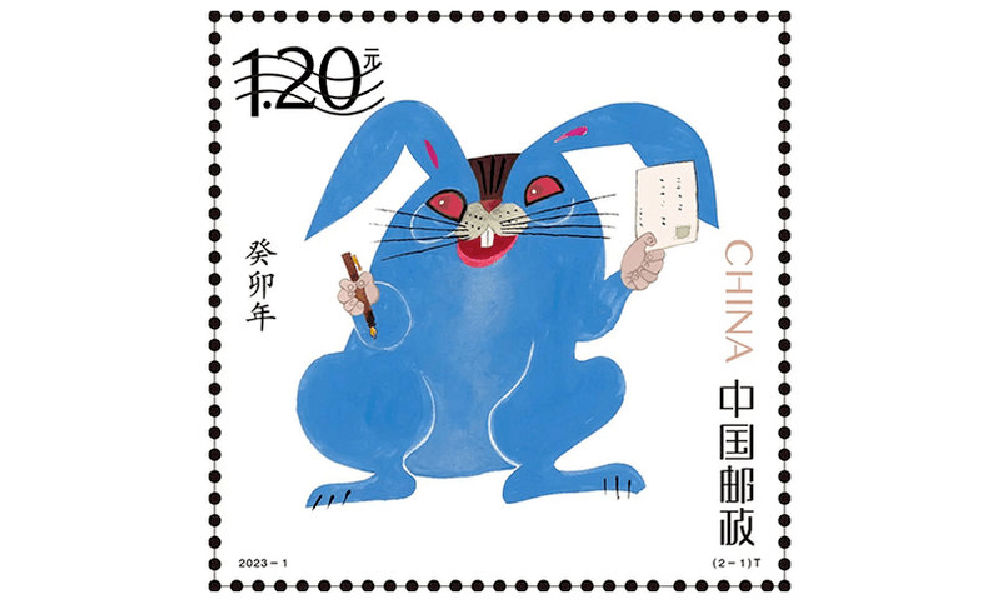
Huang’s (in)famous blue rabbit stamp.
Nevertheless, many people lined up at post offices for the stamps and they immediately sold out.
In light of the controversy, Huang Yongyu spoke about the stamps in a livestream in January of 2023. The 98-year-old artist claimed he had simply drawn the rabbit to spread joy and celebrate the new year, stating, “Painting a rabbit stamp is a happy thing. Everyone could draw my rabbit. It’s not like I’m the only one who can draw this.”
Huang’s response also went viral, with one Weibo hashtag dedicated to the topic receiving over 12 million views (#蓝兔邮票设计者直播回应争议#) at the time. Those defending Huang emphasized how it was precisely his playful, light, and unique approach to art that has made Huang’s work so famous.
A Self-Made Artist
“I’m ugly, but my mum likes me”
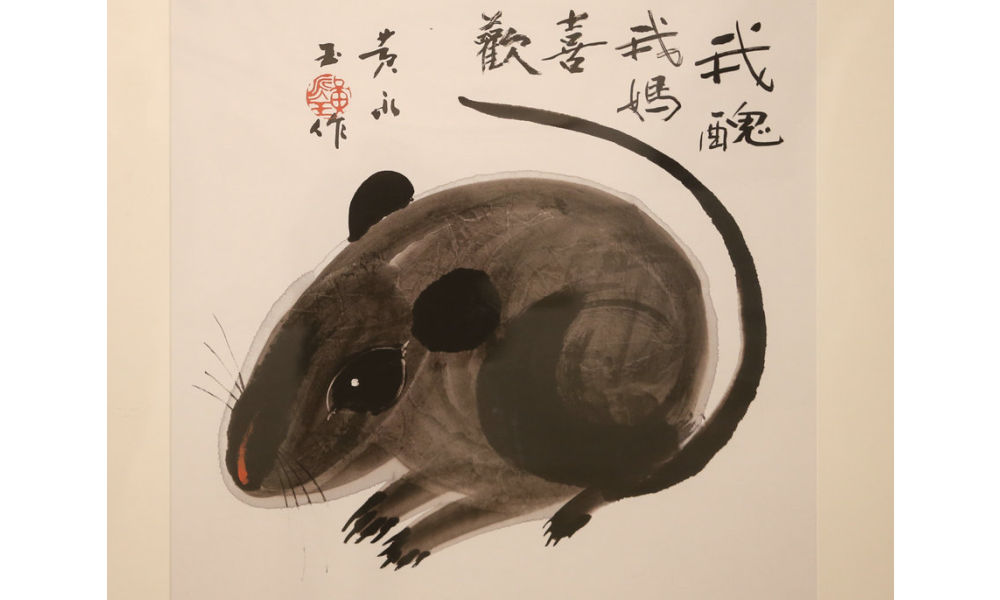
‘Ugly Mouse’ by Huang Yongyu [Image via China Daily].
Huang Yongyu was born on August 9, 1924, in Hunan’s Chengde as a native of the Tujia ethnic group.
He was born into an extraordinary family. His grandfather, Huang Jingming (黄镜铭), worked for Xiong Xiling (熊希齡), who would become the Premier of the Republic of China. His first cousin and lifelong friend was the famous Chinese novelist Shen Congwen (沈从文). Huang’s father studied music and art and was good at drawing and playing the accordion. His mother graduated from the Second Provincial Normal School and was the first woman in her county to cut her hair short and wear a short skirt (CCTV).
Born in times of unrest and poverty, Huang never went to college and was sent away to live with relatives at the age of 13. His father would die shortly after, depriving him of a final goodbye. Huang started working in various places and regions, from porcelain workshops in Dehua to artisans’ spaces in Quanzhou. At the age of 16, Huang was already earning a living as a painter and woodcutter, showcasing his talents and setting the foundation for his future artistic pursuits.
When he was 22, Huang married his first girlfriend Zhang Meixi (张梅溪), a general’s daughter, with whom he shared a love for animals. He confessed his love for her when they both found themselves in a bomb shelter after an air-raid alarm.

Huang and Zhang Meixi [163.com]
In his twenties, Huang Yongyu emerged as a sought-after artist in Hong Kong, where he had relocated in 1948 to evade persecution for his left-wing activities. Despite achieving success there, he heeded Shen Congwen’s advice in 1953 and moved to Beijing. Accompanied by his wife and their 7-month-old child, Huang took on a teaching position at the esteemed Central Academy of Fine Arts (中央美术学院).
The couple raised all kinds of animals at their Beijing home, from dogs and owls to turkeys and sika deers, and even monkeys and bears (Baike).
Throughout Huang’s career, animals played a significant role, not only reflecting his youthful spirit but also serving as vehicles for conveying satirical messages.
One recurring motif in his artwork was the incorporation of mice. In one of his famous works, a grey mouse is accompanied by the phrase ‘I’m ugly, but my mum likes me’ (‘我丑,但我妈喜欢’), reinforcing the notion that regardless of our outward appearance or circumstances, we remain beloved children in the eyes of our mothers.
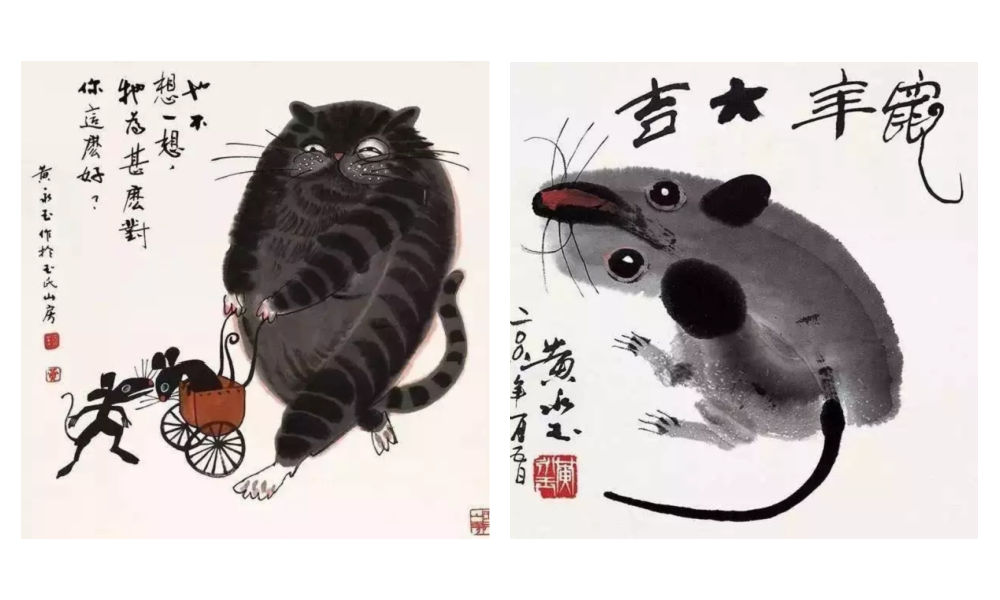
As a teacher, Huang liked to keep his lessons open-minded and he, who refused to join the Party himself, stressed the importance of art over politics. He would hold “no shirt parties” in which his all-male studio students would paint in an atmosphere of openness and camaraderie during hot summer nights (Andrews 1994, 221; Hawks 2017, 99).
By 1962, creativity in the classroom was limited and there were far more restrictions to what could and could not be created, said, and taught.
Bright Colors in Dark Times
“Strengthen my resolve and increase the fun of living”

Huang Yongyu’s winking owl, 1973, via Wikiart.
In 1963, Huang was sent to the countryside as part of the “Four Cleanups” movement (四清运动, 1963-1966). Although Huang cooperated with the requirement to attend political meetings and do farm work, he distanced himself from attempts to reform his thinking. In his own time, and even during political meetings, he would continue to compose satirical and humorous pictures and captions centered around animals, which would later turn into his ‘A Can of Worms’ series (Hawks 2017, 99; see Morningsun.org).
Three years later, at the beginning of the Cultural Revolution, many Chinese major artists, including Huang, were detained in makeshift jails called ‘niupeng‘ (牛棚), cowsheds. Huang’s work was declared to be counter-revolutionary, and he was denounced and severely beaten. Despite the difficult circumstances, Huang’s humor and kindness would remind his fellow artist prisoners of the joy of daily living (2017, 95-96).
After his release, Huang and his family were relocated to a cramped room on the outskirts of Beijing. The authorities, thinking they could thwart his artistic pursuits, provided him with a shed that had only one window, which faced a neighbor’s wall. However, this limitation didn’t deter Huang. Instead, he ingeniously utilized vibrant pigments that shone brightly even in the dimly lit space.
During this time, he also decided to make himself an “extra window” by creating an oil painting titled “Eternal Window” (永远的窗户). Huang later explained that the flower blossoms in the paining were also intended to “strengthen my resolve and increase the fun of living” (Hawks 2017, 4; 100-101).
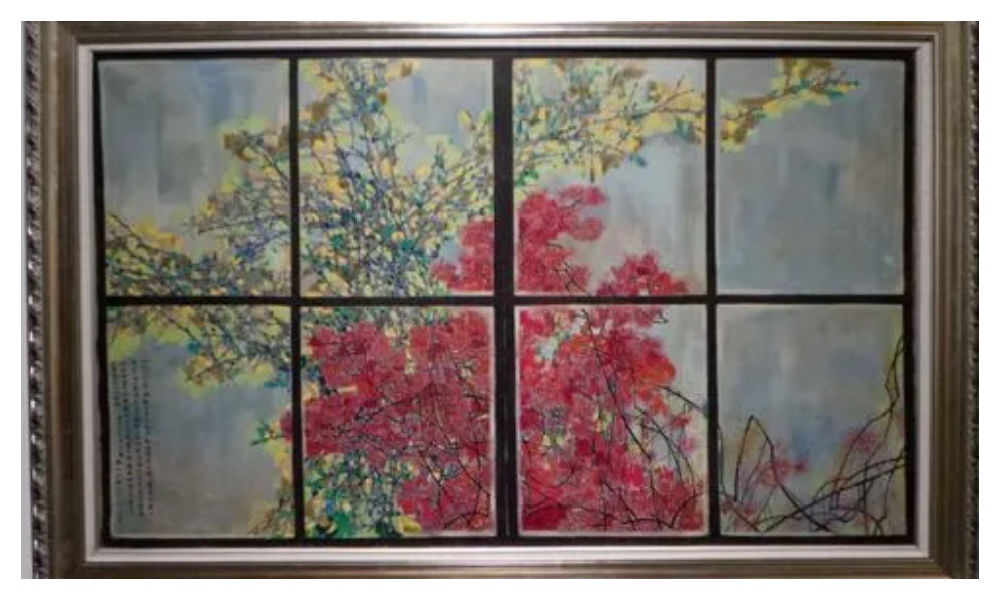
Huang Yongyu’s Eternal Window [Baidu].
In 1973, during the peak of the Cultural Revolution, Huang painted his famous winking owl. The calligraphy next to the owl reads: “During the day people curse me with vile words, but at night I work for them” (“白天人们用恶毒的语言诅咒我,夜晚我为他们工作”) (Matthysen 2021, 165).
The painting was seen as a display of animosity towards the regime, and Huang got in trouble for it. Later on in his career, however, Huang would continue to paint owls. In 1977, when the Cultural Revolution had ended, Huang Yongyu painted other owls to ridicules his former critics (2021, 174).

According to art scholar Shelly Drake Hawks, Huang Yongyu employed animals in his artwork to satirize the realities of life under socialism. This approach can be loosely compared to George Orwell’s famous novel Animal Farm.
However, Huang’s artistic style, vibrant personal life, and boundary-pushing work ethic also draw parallels to Picasso. Like Picasso, Huang embraced a colorful life, adopted an innovative approach to art, and challenged artistic norms.
An Optimist Despite All Hardships
“Quickly come praise me, while I’m still alive”

Huang Yongyu will be remembered in China with love and affection for numerous reasons. Whether it is his distinctive artwork, his mischievous smile and trademark pipe, his unwavering determination to follow his own path despite the authorities’ expectations, or his enduring love for his wife of over 75 years, there are countless aspects to appreciate and admire about Huang.
One things that is certainly admirable is how he was able to maintain a youthful and joyful attitude after suffering many hardships and losing so many friends.
“An intriguing soul. Too wonderful to describe,” one Weibo commenter wrote about Huang, sharing pictures of Huang Yongyu’s “Scenes of Pooping” (出恭图) work.

Old age did not hold him back. At the age of 70, his paintings sold for millions. When he was in his eighties, he was featured on the cover of Esquire (时尚先生) magazine.
At the age of 82, he stirred controversy in Hong Kong with his “Adam and Eve” sculpture featuring male and female genitalia, leading to complaints from some viewers. When confronted with the backlash, Huang answered, “I just wanted to have a taste of being sued, and see how the government would react” (Ora Ora).
I'm guessing the 98-year-old Huang loved the controversy. When confronted with backlash for his sculpture featuring male and female genitalia in 2007 Hong Kong, Huang answered, "I just wanted to have a taste of being sued, and see how the government would react." pic.twitter.com/kG0MVVM4SN
— Manya Koetse (@manyapan) June 15, 2023
In his nineties, he started driving a Ferrari. He owned mansions in his hometown in Hunan, in Beijing, in Hong Kong, and in Italy – all designed by himself (Chen 2019).
Huang kept working and creating until the end of his life. “It’s good to work diligently. Your work may be meaningful. Maybe it won’t be. Don’t insist on life being particularly meaningful. If it’s happy and interesting, then that’s great enough.”
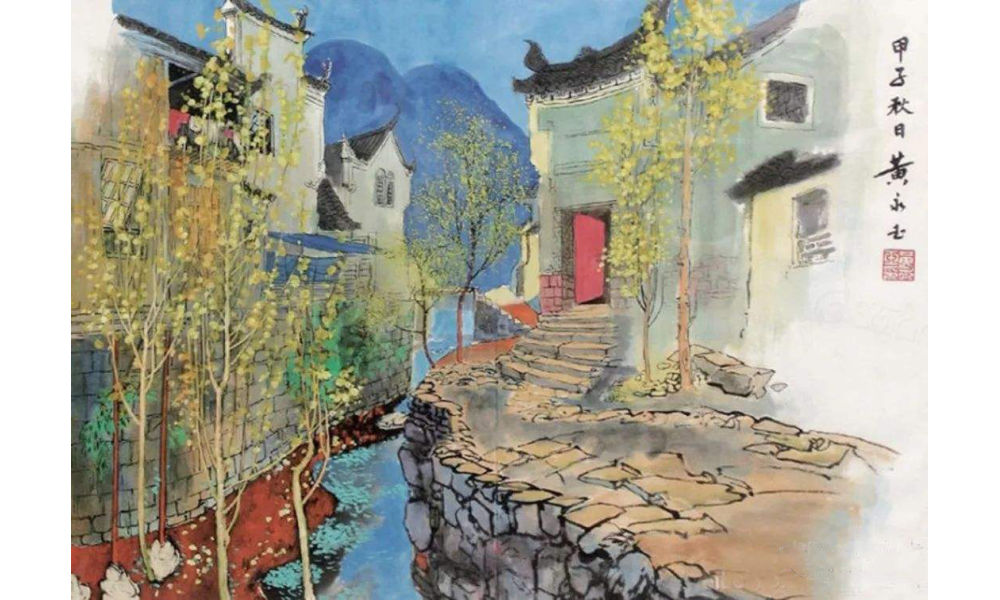
“Hometown Scenery” or rather “Hunan Scenery” (湘西风景) by Huang.
Huang did not dread the end of his life.
“My old friends have all died, I’m the only one left,” he said at the age of 95. He wrote his will early and decided he wanted a memorial service for himself before his final departure. “Quickly come praise me, while I’m still alive,” he said, envisioning himself reclining on a chair in the center of the room, “listening to how everyone applauds me” (CCTV, Sohu).
He stated: “I don’t fear death at all. I always joke that when I die, you should tickle me first and see if I’ll smile” (“对死我是一点也不畏惧,我开玩笑,我等死了之后先胳肢我一下,看我笑不笑”).
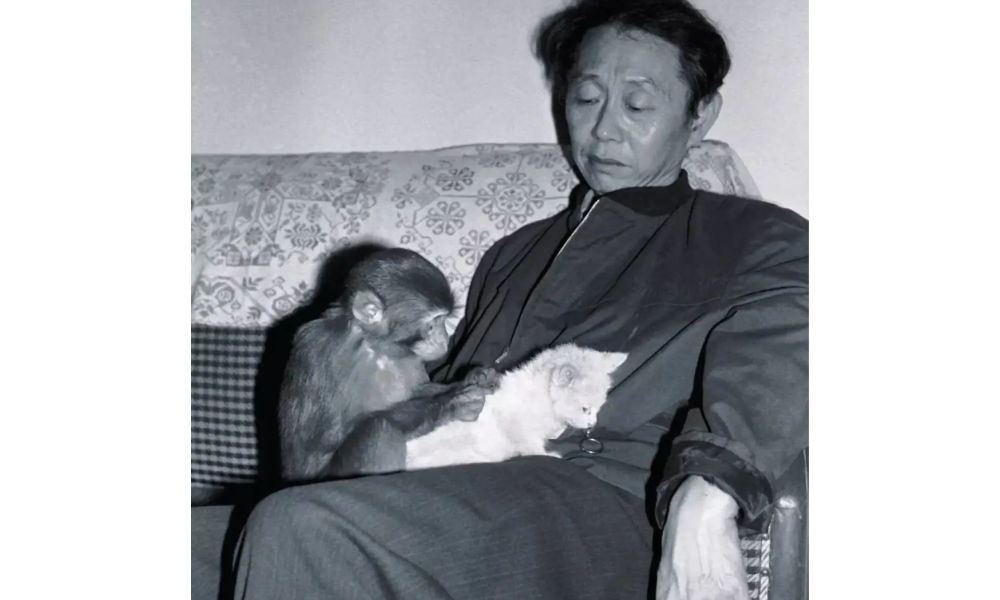
Huang with Yiwo (伊喔), the original model for the monkey stamp [Shanghai Observer].
Huang also was not sentimental about what should happen to his ashes. In a 2019 article in Guangming Daily, it was revealed that he suggested to his wife the idea of pouring his ashes into the toilet and flushing them away with the water.
However, his wife playfully retorted, saying, “No, that won’t do. Your life has been too challenging; you would clog the toilet.”
To this, Huang responded, “Then wrap my ashes into dumplings and let everyone [at the funeral] eat them, so you can tell them, ‘You’ve consumed Huang Yongyu’s ashes!'”
But she also opposed of that idea, saying that they would vomit and curse him forever.
Nevertheless, his wife expressed opposition to this idea, citing concerns that it would cause people to vomit and curse him indefinitely.
In response, Huang declared, “Then let’s forget about my ashes. If you miss me after I’m gone, just look up at the sky and the clouds.” Eventually, his wife would pass away before him, in 2020, at the age of 98, having spent 77 years together with Huang.
Huang will surely be missed. Not just by the loved ones he leaves behind, but also by millions of his fans and admirers in China and beyond.
“We will cherish your memory, Mr. Huang,” one Weibo blogger wrote. Others honor Huang by sharing some of his famous quotes, such as, “Sincerity is more important than skill, which is why birds will always sing better than humans” (“真挚比技巧重要,所以鸟总比人唱得好”).
Among thousands of other comments, another social media user bid farewell to Huang Yongyu: “Our fascinating Master has transcended. He is now a fascinating soul. We will fondly remember you.”
By Manya Koetse
Get the story behind the hashtag. Subscribe to What’s on Weibo here to receive our newsletter and get access to our latest articles:
References
Andrews, Julia Frances. 1994. Painters and Politics in the People’s Republic of China, 1949-1979. Berkley: University of California Press.
Baike. “Huang Yongyu 黄永玉.” Baidu Baike https://baike.baidu.com/item/%E9%BB%84%E6%B0%B8%E7%8E%89/1501951 [June 14, 2023].
CCTV. 2023. “Why Everyone Loves Huang Yongyu [为什么人人都爱黄永玉].” WeChat 央视网 June 14.
Chen Hongbiao 陈洪标. 2019. “Most Spicy Artist: Featured in a Magazine at 80, Flirting with Lin Qingxia at 91, Playing with Cars at 95, Wants Memorial Service While Still Alive [最骚画家:80岁上杂志,91岁撩林青霞,95岁玩车,活着想开追悼会].” Sohu/Guangming Daily March 16: https://www.sohu.com/a/301686701_819105 [June 15, 2023].
Hawks, Shelley Drake. 2017. The Art of Resistance Painting by Candlelight in Mao’s China. Seattle: University of Washington Press.
Matthysen, Mieke. 2021. Ignorance is Bliss: The Chinese Art of Not Knowing. Palgrave Macmillan.
Ora Ora. “HUANG YONGYU 黃永玉.” Ora Ora https://www.ora-ora.com/artists/103-huang-yongyu/ [June 15, 2023].
Spotted a mistake or want to add something? Please let us know in comments below or email us. First-time commenters, please be patient – we will have to manually approve your comment before it appears.
©2023 Whatsonweibo. All rights reserved. Do not reproduce our content without permission – you can contact us at info@whatsonweibo.com.
Subscribe

Weibo Watch: The Future is Here

“Bye Bye Biden”: Biden’s Many Nicknames in Chinese

Enjoying the ‘Sea’ in Beijing’s Ditan Park

A Triumph for “Comrade Trump”: Chinese Social Media Reactions to Trump Rally Shooting

Weibo Watch: Get Up, Stand Up

The Tragic Story of “Fat Cat”: How a Chinese Gamer’s Suicide Went Viral

“Old Bull Eating Young Grass”: 86-Year-Old Chinese Painter Fan Zeng Marries 36-Year-Old Xu Meng

A Brew of Controversy: Lu Xun and LELECHA’s ‘Smoky’ Oolong Tea

Singing Competition or Patriotic Fight? Hunan TV’s ‘Singer 2024’ Stirs Nationalistic Sentiments

Zara Dress Goes Viral in China for Resemblance to Haidilao Apron

Weibo Watch: The Battle for the Bottom Bed

About the “AI Chatbot Based on Xi Jinping” Story

China’s Intensified Social Media Propaganda: “Taiwan Must Return to Motherland”

Weibo Watch: Telling China’s Stories Wrong

Saying Goodbye to “Uncle Wang”: Wang Wenbin Becomes Chinese Ambassador to Cambodia
Get in touch
Would you like to become a contributor, or do you have any tips or suggestions? Get in touch here!
Popular Reads
-

 China Insight3 months ago
China Insight3 months agoThe Tragic Story of “Fat Cat”: How a Chinese Gamer’s Suicide Went Viral
-

 China Music4 months ago
China Music4 months agoThe Chinese Viral TikTok Song Explained (No, It’s Not About Samsung)
-

 China Digital10 months ago
China Digital10 months agoToo Sexy for Weibo? Online Discussions on the Concept of ‘Cābiān’
-

 China Arts & Entertainment12 months ago
China Arts & Entertainment12 months agoBehind 8 Billion Streams: Who is Dao Lang Cursing in the Chinese Hit Song ‘Luocha Kingdom’?


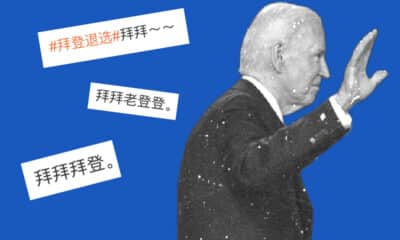


Genchi
June 20, 2021 at 4:13 pm
‘WUHEQILIN’ 五合麒麟
It’s actually ‘乌合麒麟’,not ‘五合麒麟’
Admin
June 21, 2021 at 11:16 am
Thanks for spotting the typo, it’s been adjusted!
Pixelart123
April 14, 2022 at 6:17 am
I really like Digital Art. It shows creativity in a new way of thinking of people.